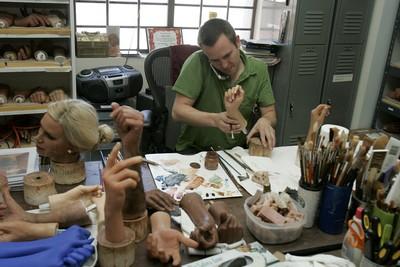WAX ON, WAX OFF
People can't seem to keep their hands to themselves in Madame Tussauds wax museum at The Venetian.
And that's enough to keep Neil Linssen, an artist and Madame Tussauds' studio manager, away from the museum during business hours.
He's horrified to see the things people do to the wax figures. Even though visitors are encouraged to touch and interact with the statues, Linssen considers them works of art.
"I'm going to see (the damage) the next day, anyway. I'd rather not see it happen," Linssen says. "Sometimes one person can go through and create a lot of work for you."
Linssen knows how delicate the "skin" is, how difficult it is to wash away the lipstick that well-meaning women leave behind on the cheeks of George Clooney; how hard it is to reinsert the hair on Don King's head, or any figure's head, for that matter. A shattered head? Nearly impossible to repair, but it has been done before, twice.
As studio manager for the museum, Linssen's job is to do those things, and more, nearly every day. He and his staff of three devote their time to either repairing or maintaining the figures, which cost on average $300,000 to sculpt.
On a recent Wednesday, Linssen planned to spend the day touching up the hands of porn star Jenna Jameson's wax figure. The body was already boxed up to be sent to the Madame Tussauds museum in Amsterdam, the Netherlands.
Jameson's statue requires a lot of maintenance, compared to some of the other figures, but that's because it is one of the more popular ones, Linssen says.
When it was unveiled, wearing only a G-string and with arms strategically placed in front of a bare chest, it featured a replica of the porn star's ankle tattoo. When rubbed, it activated one of eight sound bites from the actress. After two days on the floor, the tattoo had been rubbed off and the sound mechanism broken.
The museum prides itself on its hands-on policy, says Adrian Jones, general manager of Madame Tussauds Las Vegas. Management expects the wax figures to be damaged because of that, he notes. About $65,000 a year is budgeted for wax, paint, hair, clothing and other materials for the upkeep of the figures here. That's in addition to the cost of maintaining the studio staff, he adds.
"It's expensive to take the approach that customers can touch the figures, but that's what they want," Jones says. And with more than 500,000 people visiting the attraction every year, it's a given that damage will occur.
Every morning about 7 a.m., staff does a walk-through of the museum, restyling hair, pushing chunks of wax back into place or adjusting the figures' clothing.
Guests seem to love running their hands through hair, Linssen says, and checking to see if the figures are anatomically correct (they aren't). Often, he finds that Shaq's shorts are askew or Jameson's G-string is ripped.
"It's the curiosity factor," Linssen says.
Usually the interactive statues or those with extended hands take the most damage, Linssen notes. For instance, when guests put their hand on the rear of Jennifer Lopez's statue, the cheeks blush. As a result, the blue dress has to be repaired or changed frequently because it gets dirty and wears out.
"When her cheeks glow, people want to touch them. We have to strip her cheeks down every three or four months because of scratches and paint buildup," Linssen says.
Stevie Wonder's wax hands -- which were poised over an organ -- had to be replaced with Fiberglas ones because guests would break the fingers off. Evander Holyfield's right ear, the one that was bitten by boxer Mike Tyson, has come off as a result of too much handling.
Figures that wear jewelry, such as Tupac Shakur and Jameson, also receive a lot of attention. The jewelry gets broken because people mistake it for the real thing, Linssen says. Although it looks real, Jameson's figure is not wearing a Rolex.
"Women who wear lipstick is one of our pet peeves," Linssen says.
George Clooney's figure stands at the altar in the wedding chapel room. Guests can don a wedding dress and "marry" him. They often end the ceremony with a kiss on the cheek.
"Once there's lipstick on, it's hard to take it off," Linssen explains, adding that the chemicals strip detail off the wax. The repairs also build up over time and require stripping. That also causes a loss of detail.
"Anybody that's sexy is going to get groped," he adds.
One of the worst things to happen happened to the Holyfield figure. It lost its head. Someone knocked it off and it fell to the floor and shattered, Linssen says. Usually, that fate sounds the death knell for a figure but one of his artists was able to piece it back together. (Arnold Schwarzenegger's head shattered once, too, but that was an accident, Linssen says.)
The polarizing figures also get picked on, Adrian says. Shortly after the last presidential election, a guest punched George W. Bush (the statue) and broke its nose off. People like to get up into the face of "American Idol's" Simon Cowell figure and tell it off.
"Certain figures people like to take their aggression out on. Anyone who people have a love/hate relationship with gets a lot of damage," Linssen says. "Luckily I have some talented staff who can repair the damage."
























